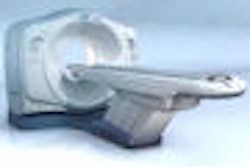LAS VEGAS - Retrospective studies have shown that contrast-induced nephropathy (CIN) following CT occurs in about 1% to 12% of patients undergoing contrast-enhanced CT. These studies also demonstrate an association between CIN and mortality. However, the value of these studies has been limited by their narrow recruiting criteria.
A new prospective study, presented on Tuesday at the 2008 International Symposium on Multidetector-Row CT, found that contrast-enhanced CT can be safely performed in most patients with chronic kidney disease.
The major retrospective studies suffer from ascertainment bias because they evaluate only a limited number of patients whose creatinine levels are tested after CT, according to Dr. Steven Weisbord, a nephrologist with the VA Pittsburgh Healthcare System and associate professor of medicine at the University of Pittsburgh.
"Important questions ... does contrast-induced nephropathy equal clinically significant contrast-induced nephropathy, and how common is clinically significant contrast-induced nephropathy?" Weisbord said in his presentation on Tuesday.
Important studies to date include an analysis by Tepel et al, who evaluated CIN in 83 patients with kidney disease who were given N-acetylcysteine as a protective agent before contrast-enhanced CT (New England Journal of Medicine, July 20, 2000, Vol. 343:3, pp. 180-184). The study defined CIN as an increase of 0.5 mg/dL, and 12% of patients experienced at least that level of decline in renal function, Weisbord said.
"However, contrast-induced nephropathy leading to dialysis or death in this study did not occur," he said.
A randomized double-blind study by Barrett et al compared the effects of iopamidol-370 injection (796 mOsm/kg) and iodixanol-320 (290 mOsm/kg) in 153 patients with chronic kidney disease undergoing contrast-enhanced MDCT (Investigative Radiology, November 2006, Vol. 41:11, pp. 815-821).
CIN, defined as an increase in serum creatinine of 0.5 mg/dL or greater, occurred in 1.3% of patients, but again there were no cases of CIN requiring dialysis or hospitalization.
"These studies would suggest that the development of CIN doesn't equal clinically significant contrast-induced nephropathy," Weisbord said. A prospective study conducted at Weisbord's institution, currently in press, sought to "assess the use of preventive care in outcomes in patients who are undergoing nonemergent procedures," he said.
The group enrolled 421 patients (127 inpatients, 294 outpatients), mean age 69, with chronic kidney disease and estimated glomerular filtration rates less than 60 mL/min per 1.73 m² of body size. Serum creatinine was measured in all patients at baseline and 48 to 96 hours following the procedure. Contrast-induced nephropathy was defined as serum creatinine increase of at least 25%, or an increase of 0.5 mg/dL.
"They were an elderly population, almost all of them were male because it was a VA study, and there were important differences in comorbidities that one would expect (between) inpatients and outpatients," such as a higher rate of diabetes among inpatients, he said. Median estimated glomerular filtration rate was 52, indicating stage III chronic kidney disease as defined by the National Kidney Foundation.
The use of preventive care was restricted primarily to inpatients. For example, IV fluids were given far more commonly in inpatients (49%) than in outpatients (< 10%). Only 9% of outpatients received N-acetylcysteine versus 38% of inpatients. Twenty-six percent of inpatients increased their intake of oral fluids, compared with 18% of patients overall.
Thirty-day follow-up was performed both by record review and by interviewing patients by telephone, Weisbord said.
Absolute (> 0.5 mg/dL) and relative (> 25%) serum creatinine increases affected, respectively, 3.5% and 6.5% of patients overall; 6.7% and 12.6% of inpatients; and 2% and 3.6% of outpatients.
In the subset of patients with advanced chronic kidney disease (defined as estimated glomerular filtration rate less than 45 mL/min per 1.73 m² body size), absolute and relative creatinine increases affected, respectively, 13% and 13% of inpatients and 8.3% and 11% of outpatients.
"There was little difference between inpatients and outpatients, and the range of contrast-induced nephropathy was fairly similar to what was found in the Tepel study," Weisbord said.
In the majority of patients with mild chronic kidney disease (estimated glomerular filtration rate 45-60 mL/min per 1.73 m² body size), absolute and relative creatinine increases affected, respectively, 5.7% and 12.5% of inpatients and 0.9% and 2.4% of outpatients, Weisbord reported.
Notably, incidence of CIN was extremely low among outpatients with mild disease, he said.
None of the patients required dialysis. Overall mortality at 30 days postprocedure was 2.4% overall, 7.1% of inpatients, and 13% of inpatients with CIN, compared with 0.3% of outpatients. There were no deaths among outpatients with CIN.
"Answering our questions, contrast-induced nephropathy does not equal clinically significant contrast-induced nephropathy," Weisbord said. "Clinically significant contrast-induced nephropathy is very uncommon in patients with (estimated glomerular filtration rates) of 45 to 60 mL/min after nonemergent CT, even without the use of IV fluids in those patients."
The results suggest that contrast agents can be used safely in patients undergoing nonemergent CT scans, Weisbord said. Preventive care should be focused on inpatients and those with advanced chronic kidney disease, he said.
By Eric Barnes
AuntMinnie.com staff writer
May 14, 2008
Related Reading
Contrast agent osmolality makes no difference in PCI of renal disease patients, April 17, 2008
Automated patient-based contrast application cuts CTA contrast volume, risk, March 7, 2008
GFR no better than creatinine for predicting renal failure, December 18, 2007
Sodium bicarbonate best for prevention of contrast-induced nephropathy, October 29, 2007
Trial shows promise for preventing radiocontrast nephropathy, December 7, 2006
Copyright © 2008 AuntMinnie.com




















